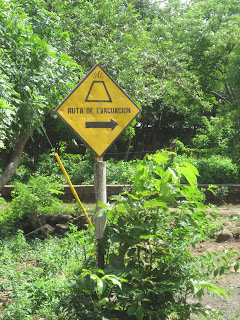Last Friday at Isabel's private international school, a splinter group of the founding parents staged an "educational coup d'état" and took over the administration and management of the school. I've been debating whether to write a post on this or not, but given the absurdity and surreal nature of what we've been experiencing, finally decided I couldn't keep it to myself.
First and foremost, all of the children are safe and it was a peaceful take over (depending on who you talk to). However, last Friday, the group, who dissolved the existing Board of Directors and installed themselves, arrived at the school with security guards, took the keys, fired the Principal and Vice Principal, and told all of the other administrative and maintenance staff to leave (some say they were fired with threats, the Junta says they only fired the Principal and vice-Principal and gave the others "vacation days."). This was all done while the children were still at school in their classrooms. A note was sent home with children explaining that the Junta had legal ownership to the school lease and grounds, that they were changing "the administration" and that there would be a meeting in two weeks to explain everything. Two weeks. Children at school during the takeover. Insane. Surreal. Frightening. Sad. Parents are ANGRY.
Since that time, there have been two formal meetings called (one by each side in the dispute), a ton of emails circulated, numerous impromptu meetings, endless conversations and discussions, and lots of "mud-slinging". Granada is a very small town and we see all of these folks on a fairly regular basis. This is a big deal. The Junta that took over has some legitimate concerns about the way the school was being run, but unfortunately by orchestrating a "coup" during school hours and not communicating or developing their plans for how they will be able to successfully run the school, they are not earning the support of many parents. Financial management ability and viability, as well as absence of any Principal/Director, let alone a qualified one, are the major concerns at this moment for most (though there is also a group that feels very personally attacked and have a much longer list of concerns and want immediate reinstatement of the former Director).
The majority of parents voted to keep their kids home this week as some teachers were unwilling to teach, it was unclear how food and security would work etc., but in the end most have ended up sending their kids in anyway. For the moment it is stable (they've said they have money to run the school for a week--promising, no?). Isabel is going back tomorrow and we will wait to see what happens next week. Right now both sides are consulting lawyers and the Ministry of Education and are supposed to be working together to come to a resolution. Given the personalities involved and the way this was carried out, I'm doubtful, but hopeful, of a resolution.
Obviously there are a lot of details and background information that I'm not writing here and needless to say, there are a lot of adults acting like children with personal grudges. Unfortunately for most families, there is no other real option for quality non-political, non-Catholic schooling in Granada. Of all of the potential challenges we imagined when moving here, Isabel's school was not one of them. Hello Nicaragua!






















